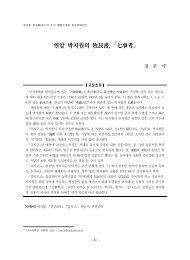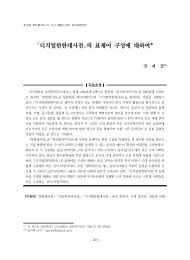Sommerfeld Model Derivation of Schrödinger Equations
Sommerfeld Model Derivation of Schrödinger Equations
Sommerfeld Model Derivation of Schrödinger Equations
Create successful ePaper yourself
Turn your PDF publications into a flip-book with our unique Google optimized e-Paper software.
Physical ElectronicsLecture 5<strong>Sommerfeld</strong> <strong>Model</strong><strong>Derivation</strong> <strong>of</strong> <strong>Schrödinger</strong> <strong>Equations</strong>Seung-Ki Lee Dankook Univ., School <strong>of</strong> Electrical, Electronic and Computer Eng. 1Mathematical Backgrounds• Operator: definition <strong>of</strong> an operation∂, ∇,∇∂x2• Linear operatorA isa linear operator ifA(Ψ + ϕ)= AΨ + AϕAλΨ= λAΨ( λ is a constant)• Eigenfunction and eigenvalueonly followings are true for arbitrary function Ψ and ϕusually AΨ ( r,t)= ϕ(r,t)but in some cases AU ( r,t)= aU ( r,t)( a is a constant)U is an eigenfunction <strong>of</strong> operator Aa is an eigenvalue <strong>of</strong> eigenfunction U→ddxeix= i ⋅eixSeung-Ki Lee Dankook Univ., School <strong>of</strong> Electrical, Electronic and Computer Eng. 2
Description <strong>of</strong> wave-particle motion2d y 2particle: + w y = 02dt22∂ y 2 ∂ ywave: = v22∂t∂x2( w =fm)start from the solution <strong>of</strong> wave equationy(x,t)= a cos( kx −ωt)→ y(x,t)= a exp[ i(kx −ωt)]using2πmv pk = = 2π=λ h hand2πEω = 2πν= hν=h hwave function Ψ ( x,t)is expressed asp E⇒ Ψ ( x,t)= a exp[ i(x − t)]:wave - particle motionh hSeung-Ki Lee Dankook Univ., School <strong>of</strong> Electrical, Electronic and Computer Eng. 3Time-dependent <strong>Schrödinger</strong> Equationp E• Start from wave function: Ψ ( x,t)a exp[ i(x t)]h− h= )]differentiate both sides for22∂ Ψ p p E= −aexp[ i(x − t)]22∂xh h h∂ΨE p E= −iaexp[ i(x − t)]∂th h h2∂ Ψ h→ −2∂xph−p22h−p222∂ Ψ ∂ΨE − ih= 02∂x∂t1( mv22 2h ∂ Ψ h− −22m∂xp22∂Ψh= −∂tiE2x and t2∂ Ψ ∂Ψ+ V ) − ih= 02∂x∂t222∂ Ψ ∂ΨV − ih= 02∂x∂t22∂ Ψ psince = − Ψ2 2∂xh2 2 2 2h ∂ Ψ h p ∂Ψ→ − − V ( − Ψ ) − ih= 02 2 22m∂xp h ∂t2 2h ∂ Ψ ∂Ψ∴− + VΨ − ih= 022m∂x∂t[Note: Ψ = Ψ ( x,t),V = V ( xTime-dependent <strong>Schrödinger</strong> equationSeung-Ki Lee Dankook Univ., School <strong>of</strong> Electrical, Electronic and Computer Eng. 4
Time-independent <strong>Schrödinger</strong> Equation• Start from time-dependent <strong>Schrödinger</strong> equationusing separation <strong>of</strong> variableslet Ψ ( x,t)= ϕ(x)⋅T( t)22∂ΨdT ∂ Ψ d ϕthen = ϕ , = T22∂tdt ∂xdx2 2h d ϕdT→ − T + VϕT− ihϕ= 022mdxdtdivide by ϕT2 2h d ϕ 1− + V − ih22mϕdx TdTdt= 02 2h d ϕ1− + V [only x]= ih22mϕdxTdTdt[only t]2 2h d ϕ∴− + V = E22mϕdx2 2h ∂ Ψ ∂Ψ− + VΨ − ih= 022m∂x∂ttΨ = ϕT= ϕ(x)exp(constant⋅ )ihcomparingp Ep EΨ = a exp[ i(x − t)]= a exp( i x)exp(−it)h hh h→ constant = E2 2h d ϕ⇒ − + Vϕ= Eϕ[Note: ϕ = ϕ(x)]22mdxthis is possible only when it is a constant1ihTdTdtt= constant → T = exp(constant ⋅ )ihTime-independent <strong>Schrödinger</strong> equationSeung-Ki Lee Dankook Univ., School <strong>of</strong> Electrical, Electronic and Computer Eng. 5Time-independent <strong>Schrödinger</strong> Equation• Operator equation and meaning2 2h d ϕ− + Vϕ= Eϕ22mdx2 2h dHamilton operator (Hamiltonian): H = − + V22mdx→ Hϕ= Eϕϕ : wavefunction <strong>of</strong> an electron2h(in 3- dim. H = − ∇2m2+ V )wavefunction → eigenfunction <strong>of</strong> Hamiltonian, E → eigenvaluesolving Schrodinger equation → finding eigenfunction ϕ <strong>of</strong> Hamiltonian∗ ∗probability <strong>of</strong> finding an electron ϕϕ → ϕϕ ∆V∗∫ ϕϕ dV = 1: normalization <strong>of</strong> wavefunctionSeung-Ki Lee Dankook Univ., School <strong>of</strong> Electrical, Electronic and Computer Eng. 6
















